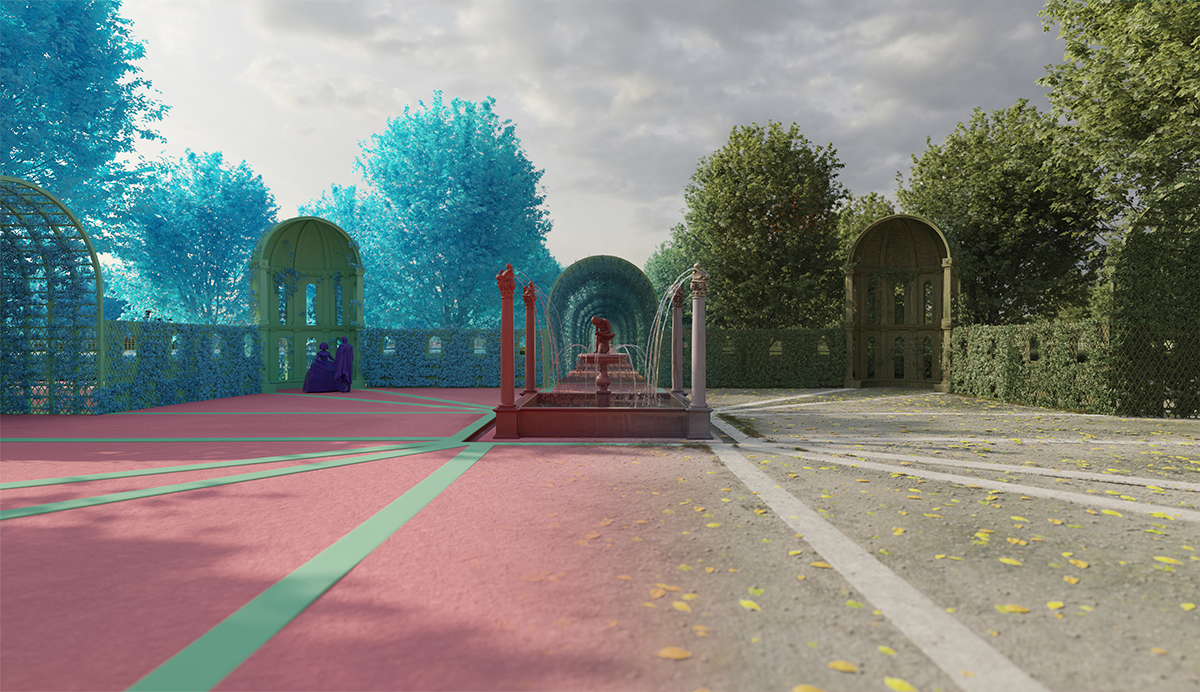in the volume Historical gardening and virtual metaphor they present themselves eight investigations on Iberian gardens from the 16th to 18th centuriesUsing documentary and graphic sources as a basis for digital reconstruction from those lost gardens or strongly transformed nowadays.
The collective book is one of the results of the project R&D FEST-digital, «Digitizing The Baroque Festival. Virtual reconstructions of ephemeral ornament in Spain and Portugal (17th and 18th centuries)», in which the professors Cristóbal Marín Tovar and Sergio Román Aliste (Art History area). The FEST-digital project seeks to digitalize and virtually reconstruct the baroque festivity and ephemeral ornaments of Spain and Portugal during the 17th and 18th centuries. One of the lines of work has focused on limited natural spaces that, despite not constituting ephemeral architectures per se, they are changing places that can be studied and reconstructed through digital technologies advanced. The chosen spaces cover the centuries of the modern age, With several examples from the city of Madrid and Aranjuez, as well as other gardens located in Cáceres, Córdoba and in the city of Lisbon.
 Firstly, Victoria Soto and Sergio Román address the urban garden of the II Count of Solre in Madrid. This chapter displays a deductive methodology based on the integration of graphic, planimetric and pictorial sources for virtually rebuild a garden of the first half of seventeenth century with strong flamenco influences.
Firstly, Victoria Soto and Sergio Román address the urban garden of the II Count of Solre in Madrid. This chapter displays a deductive methodology based on the integration of graphic, planimetric and pictorial sources for virtually rebuild a garden of the first half of seventeenth century with strong flamenco influences.
Cristina Muñoz-Delgado de Mata presents the garden of the Abbey of the 3rd Duke of Alba. The study focuses on a garden practically forgotten to this day, Located in the Cáceres province. Using historical documents and visual records, this chapter reconstruct the garden and discuss its cultural and social significanceas well as his impact in the gardening and landscape design practices of his time.
In third place, Cristóbal Marín and Sergio Román they study the orchard of the Duke of Lerma in Madrid, evaluating how pictorial views can be used as scientific tools to reconstruct and better understand historical spaces. Through a study of the Duke of Lerma's orchard, a visual proposal from the only known pictorial fountain inside the garden-orchard.
Susana Varela, Pedro Flor and Alexandre González fourthly they develop the study and proposal for virtual reconstruction of an ephemeral garden in Lisbon in 1687. This chapter reconstructs a garden created in 1687 in the Terreiro do Paço Lisbon, detailing its design, cultural significance and its temporal impact during a specific event in the Portuguese capital.
Benito Rodriguez focuses on the Royal Monastery of the Encarnación of Madrid, addressing the virtual reconstruction of a historic cloister and gardens that have disappeared over time. Through virtualization, the chapter offers a look at the original design and its ornamental elements, highlighting its importance in the religious and social context of the capital Spanish during the 17th century.
El sixth chapter is dedicated to one of the most iconic fountains in the Garden of the Island of Aranjuez, by Magdalena Merlos and Sergio Román. In this case, they are explored in detail three phases of development of the aforementioned garden, using historical data to analyze changes in the design and use of space over time at the Fountain of the Harpies or the Child of the Thorn.
Isabel Solís and Juan Salvador Sanabria They study and reconstruct a ephemeral intervention in the Garden of the Buenavista Palace and its turn into the festive scene in Madrid in 1789 In the context of the celebrations of the arrival to the throne of King Charles IV and Maria Luisa of Parma.
Lastly, Francisco Manuel Espejo addresses the study and reconstruction of the Garden of the Palace of Fernán Núñez in Córdoba in different phases. It focuses on the historical evolution of this garden, showing how the different layers of design reflect the trends and styles of various periods.
As a whole, the contributions of the volume Historical gardening and virtual metaphor, allow make visible Not only examples concrete very representative of the renaissance gardening y baroque Iberian, but particularly expose the various problems and challenges who are faced with historical science for study of the historical garden using digitalization techniques.
Image: Arpías Fountain of Aranjuez- Render and degree of evicence based on a chromatic scale.

